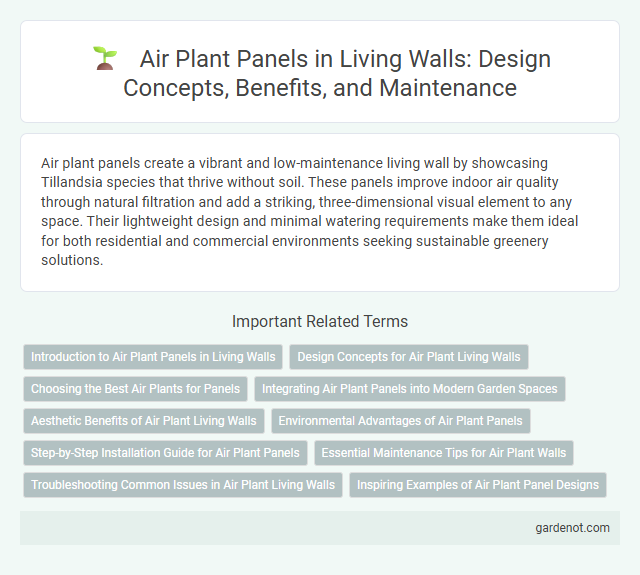Air plant panels create a vibrant and low-maintenance living wall by showcasing Tillandsia species that thrive without soil. These panels improve indoor air quality through natural filtration and add a striking, three-dimensional visual element to any space. Their lightweight design and minimal watering requirements make them ideal for both residential and commercial environments seeking sustainable greenery solutions.
Introduction to Air Plant Panels in Living Walls
Air plant panels are innovative components in living walls, designed to showcase Tillandsia species that require minimal soil and water. These panels enhance indoor air quality by naturally filtering pollutants while adding a unique aesthetic with their vibrant green textures. Their low-maintenance nature and adaptability make air plant panels ideal for modern urban interiors seeking sustainable biophilic design elements.
Design Concepts for Air Plant Living Walls
Air plant panels for living walls combine modular design with minimal maintenance, offering versatile options for both indoor and outdoor environments. These panels incorporate lightweight frames and customizable arrangements, allowing seamless integration with various architectural styles and spatial dimensions. The use of air plants eliminates soil, reducing weight and enhancing air purification, making these living walls an innovative choice for sustainable interior landscaping.
Choosing the Best Air Plants for Panels
Selecting the best air plants for living wall panels involves prioritizing species known for their resilience and low maintenance, such as Tillandsia xerographica, Tillandsia ionantha, and Tillandsia caput-medusae. These air plants thrive in indirect light and require minimal watering, making them ideal for vertical installations. Ensuring proper airflow and occasional misting enhances their longevity and vibrant appearance in any indoor or outdoor air plant panel.
Integrating Air Plant Panels into Modern Garden Spaces
Air plant panels transform modern garden spaces by providing low-maintenance, visually striking green walls that enhance air quality and promote natural humidity regulation. These panels use Tillandsia species, which absorb moisture and nutrients from the air, eliminating the need for soil and reducing maintenance efforts. Incorporating air plant panels creates dynamic, living art installations that seamlessly blend with contemporary landscape designs, offering sustainable and eco-friendly solutions for urban and indoor gardening.
Aesthetic Benefits of Air Plant Living Walls
Air plant living walls elevate interior aesthetics by introducing vibrant greenery and unique textures that create a striking visual focal point. Their low-maintenance nature and varied shapes enable dynamic designs that enhance modern, minimalist, or eclectic decor styles. Integrating air plant panels also adds depth and natural elegance, transforming blank walls into living art pieces that improve ambiance and mood.
Environmental Advantages of Air Plant Panels
Air plant panels significantly improve indoor air quality by naturally filtering pollutants and increasing oxygen levels through photosynthesis. Their low maintenance and minimal water requirements make them an eco-friendly alternative to traditional plants, reducing water consumption and waste. These panels also enhance thermal insulation, contributing to energy efficiency and lowering the carbon footprint of buildings.
Step-by-Step Installation Guide for Air Plant Panels
Air plant panel installation begins with selecting a suitable wall surface that supports moisture and airflow for optimal plant health. Secure the mounting board to the wall using screws or hooks, then attach the air plant holders or pockets evenly across the panel. Carefully insert air plants into each holder, ensuring they are stable and spaced for proper light exposure and air circulation.
Essential Maintenance Tips for Air Plant Walls
Air plant panels require consistent misting or soaking every 1 to 2 weeks to maintain optimal moisture levels for healthy growth. Ensuring proper air circulation and indirect sunlight exposure prevents mold and dehydration, crucial for sustaining vibrant air plant walls. Regularly removing dead leaves and debris promotes longevity and preserves the aesthetic appeal of living wall installations.
Troubleshooting Common Issues in Air Plant Living Walls
Air plant living walls often face issues such as brown leaf tips, which usually indicate insufficient humidity or irregular watering schedules. Lack of light can cause air plants to become pale or wilted, so placing the panel in bright, indirect sunlight helps maintain optimal health. Root rot is rare but can occur if air plants are overwatered or water is trapped in the base; ensuring proper air circulation and thorough drying after misting prevents this problem.
Inspiring Examples of Air Plant Panel Designs
Air plant panels transform indoor spaces with their low-maintenance, soil-free greenery, showcasing innovative designs like geometric wall mounts, vintage frame displays, and modular tile arrangements. Popular examples include hexagonal air plant panels that create dynamic visual patterns, while reclaimed wood backings add rustic charm and sustainability. These inspiring designs not only enhance aesthetic appeal but also improve air quality, making air plant panels a versatile choice for modern interior landscaping.
Air plant panel Infographic

 gardenot.com
gardenot.com